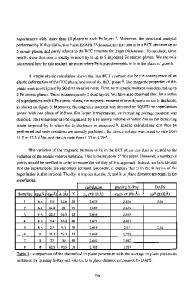HgTe-CdTe Superlattices Grown by Photo-MOCVD
- PDF / 3,635,971 Bytes
- 11 Pages / 417.6 x 639 pts Page_size
- 48 Downloads / 365 Views
HgTe-CdTe SUPERLATTICES GROWN BY PHOTO-MOCVD William L. Ahlgren,* J.B. James,* R.P. Ruth,* E.A. Patten,* and J.-L. Staudenmann** * Santa Barbara Research Center, 75 Coromar Drive, Goleta, CA 93117 "**Ames Laboratory and Department of Physics, Iowa State University, Ames, IA 50011 ABSTRACT HgTe-CdTe superlattices have been grown, for the first time, by photoSuperlattices were The substrate temperature was 182°C. assisted MOCVD. obtained despite low growth rates requiring long growth times (-10 hours). Interdiffusion during growth may be slowed down by growing under saturated Hg vapor to minimize cation-vacancy formation. The nominal superlattice structures were 7DA HgTe-30A CdTe, 40A HgTe-40A CdTe, and similar. Actual superlattice structures were verified by cross-sectional TEM and diffractometer x-ray diffraction patterns. The x-ray diffraction patterns showed satellite peaks up to third order. The actual structures had HgTe layers -20% thicker than the nominal (target) values. A grid-like array of dislocations at the substrate-epilayer interface, suggesting operation of a dislocation-blocking mechanism, was observed. Deficiencies in the superlattice growths igcludF a low growth rate, nonuniform layers, high dislocation density (H10 cm- in best layers), and hi h n-type carrier concentra2 1 3 tion (~108 cm- with mobilities up to 3.5 x 10 cm V- s- in the best layer) which may reflect the presence of donor impurities in the material. APPARATUS AND GROWTH CONDITIONS The reactor used is shown schematically in Figure 1. It is a quartz reactor with horizontal flow, containing a graphite susceptor in which a thermocouple is embedded for temperature control. The susceptor is heated from below by a quartz-halogen lamp, as described by Beneking, et al. [1]. The substrate, mounted on the susceptor, can be illuminated from The UV illumination passes through a above by a 1000W HgXe short-arc lamp. suprasil window which can be kept free of deposit by a flow of pure carrier gas. The spectrum of the HgXe lamp is modified by reflecting it from a dichroic mirror, with the result that most of the radiation reaching the substrate is in the 200 to 250 nm range. The reactants used were elemental mercury, dimethyl cadmium (DMC), and Pallaeither diethyl tellurium (DET) or di-isopropyl tellurium (DIPT). dium-diffused hydrogen was used as the carrier gas. Elemental mercury was introduced into the reactor just upstream from the substrate and was kept at the same temperature as the substrate, so that the gas flowing over the substrate was saturated with mercury vapor. All superlattice growths were carried out at a substrate temperature of 182°C. Growth of HgCdTe under Hg-saturated conditions and low temperatures is desired in order to minimize the formation of cation vacancies in the lattice, which act as acceptor defects resulting in p-type conductivity [2], and whose presence also enhances Hg self-diffusion in the lattice [3]. Thus, it is desirable to suppress the formation of cation vacancies so that the conductivity type can be controlled
Data Loading...










